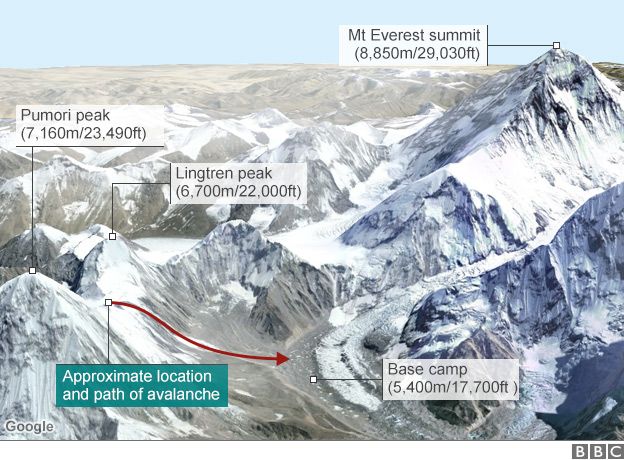Nepal earthquake: Everest survivors describe ordeal
- Published

Survivors of avalanches around the base of Mount Everest have been describing their ordeals as avalanches triggered by Nepal's earthquake on Saturday almost swept them away.
Several said they felt lucky to be alive, and admitted that they would not return to the mountain for a long time. At least 17 people died and more than 60 were injured.
Aftershocks on Sunday again spread fear among those left in the area.
One man said he was knocked off his feet by a "50-storey building of white".
"I ran and it just flattened me. I tried to get up and it flattened me again. I couldn't breathe, I thought I was dead," Singapore-based climber George Foulsham told AFP news agency.
"When I finally stood up, I couldn't believe it passed me over and I was almost untouched."
Mountaineer Arjun Vajpal at Mount Makalu base camp: "We just felt fresh tremors"
British honeymoon couple Alex Chappatte and husband Sam Schneider had just arrived at Camp 1, completing the first stage in the climb up Everest, when the earthquake hit.
"The ground started shaking violently but before we could react [Summit Climb group leader] Dan was shouting "Get out of your... tents, grab your ice axes!" Ms Chappatte wrote in her blog.
"We staggered out to see an avalanche coming straight at us. A blast of wind knocked us down but we were able to get up and run to shelter behind some tents and anchor ourselves with our axes.
She added that they were able to dig their tents out of the snow as they were only lightly covered with snow, and move to a safer place.
Ms Chappatte's post ended on an upbeat note, describing "glorious sunshine" and "incredible" views of the summit on Sunday morning.
"We've got food and the sherpas are being amazing. We're OK," she wrote.
Mount Everest
- First successful ascent was by New Zealand mountaineer Sir Edmund Hillary and Sherpa Tenzing Norgay on 29 May 1953
- More than 4,000 people have scaled the summit since then
- Hundreds of people attempt to climb Everest every year - 658 people made the summit in 2013
- More than 200 people have died trying to climb Everest
But aftershocks later in the day led to more fear and anxiety at the camp.
Climber Daniel Mazur tweeted: "Aftershock @ 1pm! Horrible here in camp 1. Avalanches on 3 sides. C1 a tiny island. We worry about icefall team below. Alive?"
Many of the injured have now been airlifted out of Base Camp, but others were not so fortunate.
US climber and cardiologist Ellen Gallant told AFP how she had worked to save those hurt in the avalanches but one young Nepali man died in front of her.
This is the worst disaster to happen on the mountain
"Of the nine patients, one of them died last night - a 25-year-old sherpa. His blood pressure had fallen - there was nothing we could do."
"When you go to medical school, you learn to focus on the task at hand. But now that things have settled down, it's hit me hard. That young man... shouldn't have to die."
The avalanches have left some survivors wondering about the future of the climb. Just a year ago the deadliest avalanche in Everest's history until then had left 16 sherpas dead.
Nepali cook Kanchaman Tamang said he had reassured his family after last year that he would be safe at Base Camp.
"The season is over - the route has been destroyed, icefall ladders are broken," he told AFP.
"I don't think I will come back next year - this mountain means too much pain."
Mr Foulsham suggested that his dream of climbing Everest might now be over.
"I saved for years to climb Everest [but] it feels like the mountain is saying it's not meant to be climbed for now," he said.
"It's too much of a coincidence to see this twice in two years."